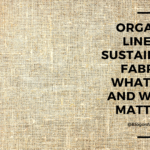
Bamboo fabric is a natural textile made from the fibers of the bamboo plant. The fibers are extracted from the plant using a process similar to that used for other natural fibers such as cotton and hemp. Increasingly more people are now using bamboo fabric due to its softness, toughness, and sustainability.
The soft suppleness of bamboo fabric is one of its most distinctive qualities. Bamboo fibres are naturally round and smooth, which gives the fabric a silky feel that is comparable to cashmere or silk. This makes it a fantastic choice for products like clothing, bedding, and other skin-contact materials.
Bamboo fabric is also highly durable. It is resistant to wear and tear, and can withstand multiple washings without losing its shape or softness. Additionally, bamboo fabric has natural antimicrobial properties which helps prevent the growth of bacteria and other microorganisms, this makes it a perfect choice for active wear, bedding, and other items that require frequent washing.
In terms of sustainability, bamboo is a highly renewable resource. Bamboo is a plant that grows quickly and matures in as little as three to five years, whereas wood-producing trees might take decades or even centuries. Additionally, bamboo requires minimal pesticides and fertilizers to grow and bamboo plantation consume less water than most other crops.
Bamboo fabric can be used for variety of purposes:
- Clothing: Bamboo fabric makes for comfortable and breathable clothing, which is suitable for all seasons, from t-shirts, dresses to socks and underwear
- Home Textiles: Bamboo is also suitable for sheets, duvet covers, towels and curtains. Because of its natural anti-bacterial and hypoallergenic properties, it’s also a great choice for people with sensitive skin.
- Medical Textile: Bamboo fiber is well-suited for bandages, gauze, and other medical products.
- Industrial Use: Bamboo fabric also has industrial uses, such as for filtration, in making of paper and for insulation.
In conclusion, bamboo fabric is a soft, durable, and sustainable textile that is well-suited for a wide variety of applications. It has many benefits over traditional fabrics like cotton and synthetic fabrics, it’s eco-friendly, and it’s suitable for various end-use. Due to these benefits, bamboo fabric is becoming an increasingly popular choice among consumers, manufacturers and textile designers.
Care Instructions
Caring for bamboo fabric is similar to caring for other natural fibers like cotton or linen. To ensure that your bamboo fabrics last as long as possible and maintain their softness and color, here are some care instructions you should follow:
- Wash bamboo fabrics in cool or warm water, using a gentle cycle and mild detergent. Avoid using bleach or fabric softeners, as these can damage the fibers and reduce the fabric’s softness.
- Do not wring or twist bamboo fabrics when removing excess water. Instead, gently press the fabric between two towels to remove any moisture.
- Tumble dry bamboo fabrics on a low heat setting or air dry them flat. Avoid hanging bamboo fabrics to dry as this can cause stretching and shrinkage.
- Iron bamboo fabrics on a low heat setting, if needed. Avoid using steam when ironing bamboo fabrics as this can damage the fibers.
- Avoid using harsh chemicals or abrasive cleaning agents on bamboo fabrics. This can damage the fibers and reduce the fabric’s softness.
- When not in use, store bamboo fabrics in a cool, dry place, away from direct sunlight and heat sources.
- If you need to remove stains or spills, it’s best to treat them as soon as possible. Use mild detergents and warm water to spot-clean the affected area, and then follow the general care instructions outlined above.
You can benefit from the smoothness and durability of bamboo fabrics for a very long time by following these care suggestions. For specific instructions on how to care for your bamboo clothing, always read the care label. With proper care, your bamboo fabrics will last for many years to come.
Check out for bamboo clothing here
Follow Blog On Fashion for the latest fashion trends and updates, also keep up with us on Twitter, Facebook, Google News, and Instagram. For our latest videos, subscribe to our YouTube channel.










